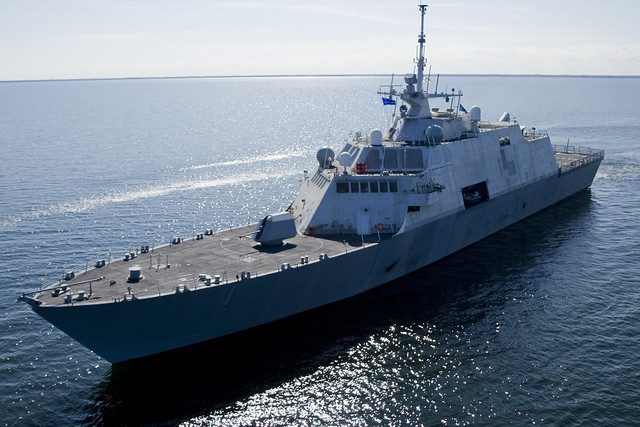
The results are in for the decade-long contest to build as many as 55 near-shore Littoral Combat Ships for the U.S. Navy. And the winner is … everybody! Instead of picking between designs from number-one arms-maker Lockheed Martin (pictured) and upstart rival Austal, now the Navy says it will buy copies of the speedy, roomy LCS from both companies, simultaneously — pending Congressional approval, of course. The move is the best sign in years that the Navy is serious about growing the fleet from today’s 280 ships to at least 313.
If the plan announced on Wednesday goes ahead, the Navy will buy an initial 10 LCS each from Lockheed and Austal between now and 2015, to add to the four LCS — two from each firm — already paid for. Cost details are still under wraps, but it appears the Navy scored a good deal on fixed-price contracts with both companies. Certainly, the 20 new ships will cost less than the roughly $600 million it cost to build each of the lead ships. Just last month, Joint Chiefs Chair Adm. Mike Mullen warned that LCS’ future hinged on price. “If LCS is unable to contain itself … then I don’t think it has much of a future,” Mullen said.
In that sense, the Navy apparently pulled a bait-and-switch on Lockheed and Austal. By pitting the two companies against each other and threatening to kill the program all-together without big savings, the Navy ensured it got the lowest possible price on both designs. Then the sea service went and locked those competitive prices into fixed-cost contracts for both companies. That ensures maximum production rates and sustains two shipyards at a time when many shipbuilders are struggling.
There are just two downsides, according to Raymond Pritchett. “Such low bids raise serious concerns whether one or both contractors bid unrealistically low prices.” Also, the two classes of LCS have separate computer systems, potentially raising certain overhead costs compared to a single-class force.
Still, the clever buying tactic means more new ships, faster. And that gives the Navy a real shot at finally reversing the slow shrinking of the U.S. fleet. The previous plan was to base all LCS in San Diego. Now the Navy is reportedly considering a second LCS base in Mayport, Florida, currently home to a rapidly decommissioning force of Cold War frigates. Each base would host just one class of LCS, thereby simplifying training and maintenance.
Besides the Navy, the Marines are another big winner in the new LCS strategy. The Corps has begun experimenting with a new “raid” concept that depends on the LCS and another, similar vessel. Instead of deploying entire battalions from big, old-school assault ships, under the raid construct companies of Marines could travel in many platoon-size groups aboard widely-scattered LCS. That would allow the same overall number of Marines to cover a wider swath of coastline. Now with more shore-hugging ships to transport them, Marine raiders could figure heavily in future operations.


